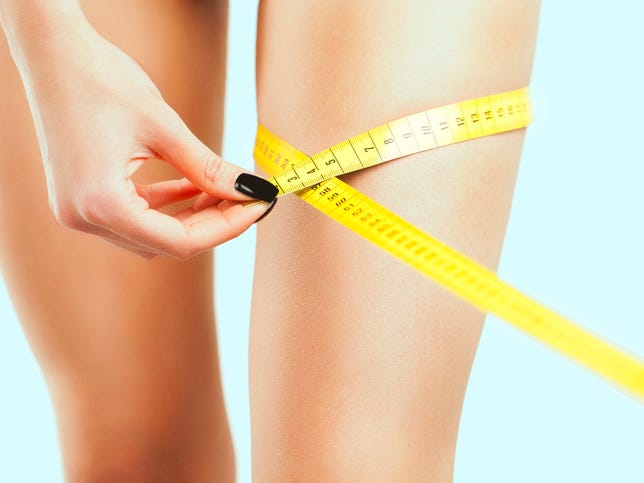
Getty Images/iStockphoto
When a woman’s feet touches, a gap between the thighs is not healthy, despite a recent trend.
Anne Becker has been studying eating disorders for nearly three decades, but it was from her twin 13-year-old daughters that she learned the term “thigh gap.”
Her daughters got their Seventeen magazine and pulled up website images to show Becker, a psychiatrist and eating disorders specialist at Harvard Medical School, what a thigh gap looks like.
“They said kids at school talk about it offhandedly like, ‘Well, you have a thigh gap, so you can have the extra ice cream,’ ” Becker says.
This disturbing ultra-thin-body trend pressures women and girls to achieve a gap between the thighs when they stand with their feet touching.
Women’s idolization of skinny legs is not new. But the term has caught on as a popular hashtag on social media sites and a meme within the “thinspiration movement.” By achieving a thigh gap, some women believe “they’ve become a member of an exclusive club,” says Barbara Greenberg, a clinical psychologist based in Weston, Connecticut.
Erin, a 25-year-old from St. Louis, Missouri, who asked that her last name not be used to protect her privacy, said before she heard the term through social media, she remembers feeling pride when she saw a space between her thighs.
“My legs didn’t touch, and that was cool,” she says. “I used to be able to wrap my hands all the way around my legs. And that was kind of like a trophy for me that I could do that. I just wanted my legs to be as small as possible.”
Experts fear the focus on thigh gap is driving a small number of women, especially teens, into behavior that could lead to eating disorders and other destructive habits.
Most women – even those who are very thin – do not have a thigh gap, says Angela Guarda, an associate professor of psychiatry at the Johns Hopkins School of Medicine and director of the Johns Hopkins Eating Disorders Program. YouTube videos offer how-to’s on achieving a thigh gap, and some self-proclaimed experts argue there is a healthful way to achieve a thigh gap through exercise.
But eating disorder experts say the quest is dangerous, noting that even many lean athletes do not have a thigh gap. Whether a woman’s inner thighs touch depends on bone structure, shape of the pelvic girdle and how far apart the hipbones are, in addition to weight, Guarda says.
“Most women’s thighs touch somewhere from between their crotch and their knees,” even at a healthful thin weight, she says. Aside from a small minority of body types, “you have to be severely underweight for [the thighs] to separate, but that’s not the message that’s being perceived by teens.”
James Lock, director of the Eating Disorders Program for Children and Adolescents at Stanford University School of Medicine and co-author of the book “Help Your Teenager Beat an Eating Disorder,” agrees.
“Thigh gap is not a normal body shape for most women,” Lock says. To achieve it, “you’re going to have to distort and really modify your behaviors. It’s almost like a foot-binding kind of thing, it’s so distorting of the natural shape of women.”
Flirting with danger
Working to achieve unhealthful ideals such as thigh gap is flirting with danger, experts say. The quest for a thigh gap could lead to a full-fledged eating disorder, Guarda says. For example, she says, an obsession with certain body areas can lead to “body checking.”
People who do this pinch themselves often, on the stomach, thighs or elsewhere, or they use their fingers to measure their arms, wrists or thighs, and check their appearance in mirrors compulsively.
“Engaging in these body-checking behaviors is likely to reinforce body dissatisfaction and negative body image,” Guarda says.
“It’s important to remember that talking about thigh gap or being interested in it – the stuff you see in middle schools – is not in and of itself an eating disorder,” Becker says. “But what it is is sort of a pathway to conversations that set girls up for being unhappy with their bodies.”
‘Nothing tastes as good as skinny feels’
Experts say that social media are giving such terms as thigh gap and “orthorexia” -- a fixation on eating healthful food that can spark anxiety, and, paradoxically, malnutrition -- an unprecedented following.
When promulgated by social media, these terms “give people something to latch onto,” says Claire Mysko, a consultant for the National Eating Disorders Association’s youth program.
Blogging platforms such as Tumblr have become a forum for “pro-ana” (short for pro-anorexia) and “thinspiration,” or “thinspo,” communities that glamorize and glorify the pain of excessive weight loss.
On these blogs, the lines quickly blur between images of presumably healthy, bikini-clad models to starkly lean, skeletal – sometimes emaciated – women, with hash tags such as #thinspo, #depressed, #anorexic, #pale, #hip bones, #thigh gap and #sexy.
The images are accompanied by such statements as “Nothing tastes as good as skinny feels,” “Ribcage is the new black” and “Don’t eat anything today that you’ll regret tomorrow.”
.
Experts say that these platforms pose dangers for vulnerable people in part because they provide a strong sense of community.
“Now at the click of a keyboard you can access all these like-minded people who may be focusing on a very specific thing,” says Jennifer Wildes, an assistant professor of psychiatry and psychology at the University of Pittsburgh School of Medicine. “What was once anomalous now seems much more common when you can reach out to everyone in the whole world who has access to the Internet who shares those feelings or thoughts.”
If you or someone you love struggles with an eating disorder please call us at (206) 909-8022, visit us at www.RameyNutrition.com
No comments:
Post a Comment